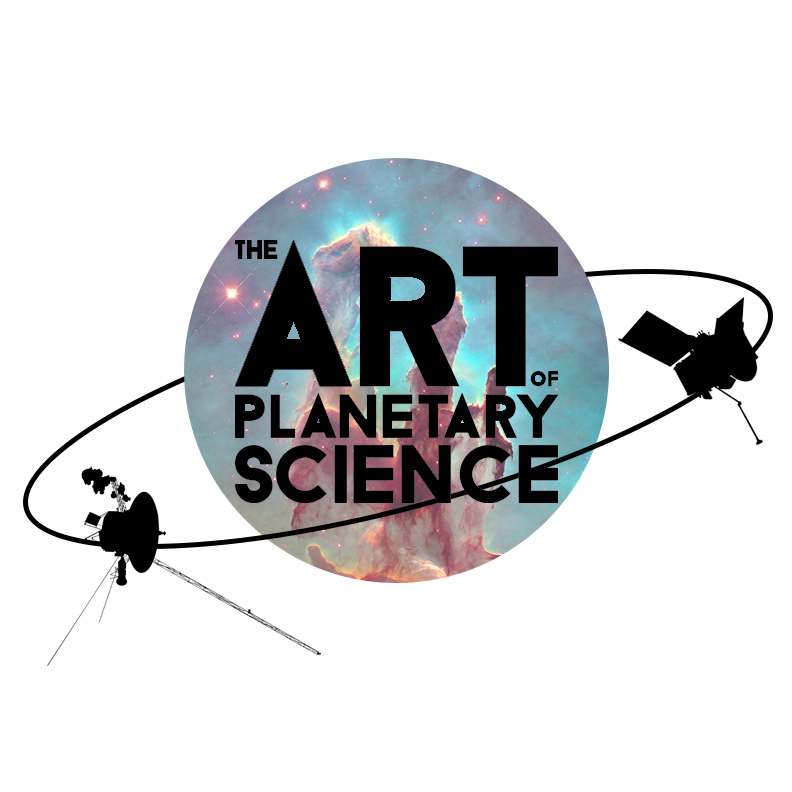The Art of Planetary Science 2021: Space Travel
 The Art of Planetary Science (TAPS) was proud to hold its 8th annual exhibition this year, with the special theme of Space Travel. Like many recent events on the University of Arizona campus, the 2021 show went hybrid, hosting 112 works of art in person and a total of 300 online! The theme was well received by the artists who submitted pieces this year, with 203 of the accepted submissions dedicated to the Space Travel theme; 54 of these were displayed in the Kuiper building for the opening weekend (September 24-26).
The Art of Planetary Science (TAPS) was proud to hold its 8th annual exhibition this year, with the special theme of Space Travel. Like many recent events on the University of Arizona campus, the 2021 show went hybrid, hosting 112 works of art in person and a total of 300 online! The theme was well received by the artists who submitted pieces this year, with 203 of the accepted submissions dedicated to the Space Travel theme; 54 of these were displayed in the Kuiper building for the opening weekend (September 24-26).
After last year’s all-virtual show, organizers were excited to offer the in-person component again. With precautions (including a mask requirement and multiple hand sanitizing stations) taken to protect guests, the Kuiper Space Sciences building atrium and the fourth-floor atrium balcony were transformed into an art gallery, open to the public over the weekend of September 24-26. The weekend was full of special events and talks available to enjoy in-person and online. TAPS had a good showing for this year, with 450 in-person visitors!
Last year (2020) was the first for TAPS online galleries and organizers decided to make them available again this year, as they allow guests from around the world to participate and access the exhibit. Five virtual art galleries (Data Art, Fine Art, Kids Art, Space Travel Art and Space Shorts) were available to view through the end of October. The online galleries also include this year’s Art of Planetary Science at DPS submissions. This tradition was started in 2017 and is typically held at the annual DPS conference, which was online only this year. DPS participants were able to vote for their favorite piece during the conference (Oct. 3-8).
TAPS partnered this year with the Interstellar Research Group (IRG) for their 7th Symposium, which was held in Tucson concurrent with the TAPS opening weekend. The Tucson Amateur Astronomy Association provided safe solar telescope viewing with hydrogen alpha filters on Sunday afternoon. The invited speaker for SciFi Sunday was astronaut Charlie Walker, who was inspired by science fiction to pursue a career in space. He became the first astronaut with a background in industry and completed three Space Shuttle flights in the 1980s. Mr. Walker helped develop and plan the International Space Station and developed and completed some of the first biological experiments in space. The longstanding partnership between TAPS and the Flandrau Science Center & Planetarium continued this year, as they provided the planetarium space for Walker’s invited presentation. You can view Walker’s recorded presentation on the TAPS YouTube channel.
This year saw the debut of the Kids’ Art gallery, which hosted 13 pieces from young artists. Organizers hope to expand this section of our show next year. This small but mighty aspect of the art show had a big impact for some of the participants, who were invited to the artists’ reception. One young artist in particular was especially excited to hear the lecture by Dr. Christopher Hamilton, who described his research adventures in Iceland, accompanied by stunning drone footage of active volcanoes. A recording of this lecture, as well as other TAPS events and videos for each art gallery, is on the TAPS YouTube channel.
Another first for 2021 was the special satellite writing project for young humans, titled Space Shorts. This call for science fiction short stories expanded the scope of the exhibit beyond visual arts into the written word. To inspire young students to submit their short stories, TAPS partnered with the University of Arizona’s Think Tank, which chose winner Henry Payne for his short story titled Spacer.
Other opening weekend events included an album release and musical performance by the local Tucson band, Daytrails, fronted by LPL undergraduate minor, David Cantillo. Saturday included a visit from Ms. Frizzle of The Magic School Bus (More to the Story Entertainment), who interacted with guests inside the art gallery and assisted the Tucson Children’s Museum in some live science demonstrations, including making a cloud in the Kuiper atrium! Guests were invited to wear their favorite space and astronomy-themed clothing on Friday and visitors did not disappoint! Festive apparel included light-up constellation clothing, tin-foil head pieces, sun and moon masks, nebulae pants, dresses portraying various planets, meteorite petrographic skirts, and alien earrings.
The Art of Planetary Science would like to thank all the collaborators, invited speakers and performers for contributing to this year’s show. Many thanks from all the past and current graduate student organizers of The Art of Planetary Science as well to LPL director Mark Marley for the continued support.
Travel to space with us again soon!

